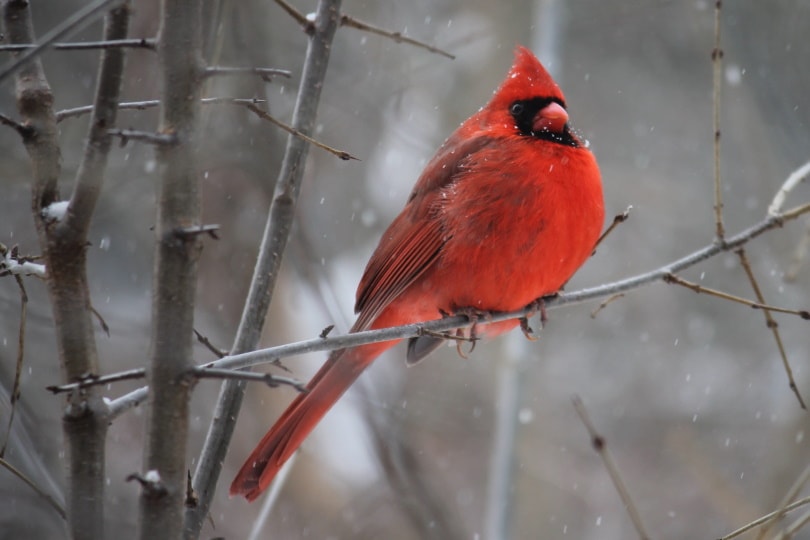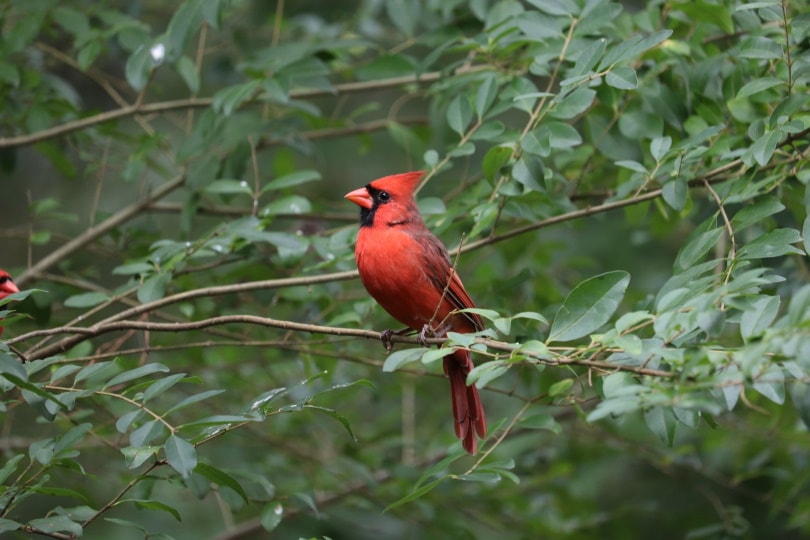15 Proven Ways To Attract Cardinals To Your Yard & Feeders
Last Updated on

Americans find wildlife fascinating. It’s one reason that 67 million individuals interact with wild animals, spending over $75 billion a year to enjoy this privilege. It only seems natural that we’d want to attract birds to our homes for a close-up view of our feathered friends. Sales of wild bird feed alone are over $2 billion a year. Over 52 million Americans put out food at least sometimes.
Cardinals are an anomaly among many birds. They are well-adapted to the presence of people. The males stand out with their bright red plumage. Even their call attracts our attention. They are so ubiquitous that it’s hard to believe that they were once a rare sighting.
You can consider cardinals to be beginner birds. They’re easy to attract as long as you provide for their basic needs. It also helps to leave out their favorite things to seal the deal. Our guide will discuss everything you need to know about making sure cardinals are visiting your yard and maybe even taking up winter residence. Then, you can enjoy their beautiful colors and delightful song year-round.
The 15 Proven Ways To Attract Cardinals To Your Yard & Feeders
1. Put Out a Birdbath.

Putting out a birdbath is sure to attract cardinals and other songbirds. It fulfills their need for water and is an excellent place to splash around and get rid of the dust from foraging for food on the ground. Make sure to keep it filled so they always have a reliable water source. You should also clean it to avoid bacterial infections.
2. Add a Bird Feeder to Your Yard.

Put out a feeder, and they will come! You can put out a feeder for seeds, which will provide the bulk of their diet. If you’re doing landscaping, you can add fruit trees, such as sumac or mulberry, to satisfy their sweet tooth. If you have year-round residents, you can also hang a suet feeder to give them a source of much-needed energy in the winter.
3. Location! Location! Location!

If you’re going to feed the cardinals, you’re likely going to have unwanted visitors too, namely squirrels. The best way to deter them is to select the location of the feeder carefully using the 5-7-9 rule. That means keep the feeder 5 feet above the ground, 7 feet from any nearby launching pads, and 9 feet away from the nearest overhead branch.
4. Fill Your Feeder With the Right Food.

Many birds are opportunistic feeders, eating whatever they can find. Cardinals prefer seeds and fruit. You can take care of the former with a tube or hopper feeder. Their favorite foods are black sunflower seeds, millet, peanut hearts, and cracked corn. We recommend buying high-quality products for optimal nutrition.
5. Make Your Feeder a Reliable Food Source.
https://www.instagram.com/p/CNXuPMoFdxs/
Putting up a feeder is a commitment, especially during the winter. If you decide to do it, it’s imperative to stick with the plan. Make it a part of your routine to check it often and top it off when it gets low. We also suggest monitoring what the birds are eating. If they’re tossing out the safflowers, pick a mix that doesn’t contain them.
6. Maintain Your Landscaping.

It’s essential to keep any overhead branches trim to keep pests from raiding your bird feeder. That also applies to any vegetation on the sides that can provide easy access to the goodies.
7. Provide Adequate Cover.

All wildlife, especially prey species, needs cover. It doesn’t have to be much for cardinals because they like to forage on the ground, anyway. Shrubs, particularly dense-growing ones, will provide ideal shelter. If you have year-round residents, consider adding evergreens to keep them safe and warm during the winter months.
8. Landscape With Native Plants.

This tip is as much for the cardinals as it is for you. Landscaping with native plants gives you an edge on maintenance when you deal with species that can tolerate your area’s climate. They’re also low maintenance. It’s no wonder that native landscaping came out on top of the American Society of Landscape Architects (ASLA) survey of most desirable projects.
9. Make Nesting Material Available.
https://www.instagram.com/p/BUfQd95l2PW/
Those shrubs you planted for cover will make excellent nesting sites. Cardinals will use the forks of trees and bushes to construct them. Providing nesting materials, such as coconut fiber for potted plants, can give them exactly what they need to make a secure place for their brood. Unlike many raptors, cardinals won’t reuse their nests the following years.
10. Make Your Yard Predator-Proof.

Predators will likely start hanging around your yard once you start feeding cardinals and other songbirds. Planting cover species will help protect them by giving them places to hide. House cats are a significant threat to many birds, taking nearly 3 billion songbirds every year. If you have a cat, we recommend keeping them indoors.
11. Provide Winter Food.

A sure way to attract and keep cardinals visiting your yard is to provide a reliable winter food source. It’s slim pickings at this time of year. Now more than ever, it’s imperative to keep the feeder filled. We suggest going with nutrient-dense mixtures that contain a blend of fruits and seeds to cover all their nutritional needs.
12. Keep the Water From Freezing.
https://www.instagram.com/p/CJWn_ysAGjO/
If you have a birdbath, it’s also essential to keep that water from freezing during winter. Along with food, open water is scarce too. You can get a heater that will keep it warm enough without using much electricity. Make sure to use an extension cord that is appropriate for outdoor use. Don’t be surprised if other wildlife takes advantage of it, though.
13. Make Sure There Are Perching Spots.

Many birds and wildlife species avoid open areas for a reason. It puts them in full view of potential predators. That’s why many animals stick to the edges for quick cover if they need it. Cardinals want a clear picture of their world for the same reason. Perching spots, such as bare branches, will give them a bird’s-eye look around their territory.
14. Give Them Space.
https://www.instagram.com/p/CNSGg5OjVfd/
While cardinals are tolerant of people, they also need their space. If possible, place your feeder and birdbath away from the kids’ swing set or the deck. Any place where there is a great deal of activity will likely send the birds looking for someplace quieter with less traffic. The same applies to the family dog. Try to keep them away from the birds, especially during the breeding season.
15. Avoid Deterrents.

Some birds are pests. Woodpeckers may peck on the side of your house, looking for food. Then, there are the migrants that may crash into a window in unfamiliar territory. That’s what makes metallic tape so effective. The flashing stripes fend off birds. However, if you want to attract cardinals, you should avoid using these products. The same thing applies to pesticides because they often eat insects too.
Conclusion
Cardinals are gorgeous birds that challenge you to notice them. Their delightful songs and silly antics make them enjoyable to have around your yard. Fortunately, these birds are easy to attract with some simple additions and modifications to your landscaping. If you’re lucky, you’ll be able to enjoy them year-round.
Check out some of our top trending bird posts:
- 5 Proven Ways To Attract Bluebirds To Your Yard & Feeders
- 20 Types of Jaybirds (with Pictures)
- 9 Proven Ways to Keep Ants OUT of Hummingbird Feeders (2021)
Featured Image Credit: Piqsels
Table of Contents
- The 15 Proven Ways To Attract Cardinals To Your Yard & Feeders
- 1. Put Out a Birdbath.
- 2. Add a Bird Feeder to Your Yard.
- 3. Location! Location! Location!
- 4. Fill Your Feeder With the Right Food.
- 5. Make Your Feeder a Reliable Food Source.
- 6. Maintain Your Landscaping.
- 7. Provide Adequate Cover.
- 8. Landscape With Native Plants.
- 9. Make Nesting Material Available.
- 10. Make Your Yard Predator-Proof.
- 11. Provide Winter Food.
- 12. Keep the Water From Freezing.
- 13. Make Sure There Are Perching Spots.
- 14. Give Them Space.
- 15. Avoid Deterrents.
- Conclusion
About the Author Robert Sparks
Robert’s obsession with all things optical started early in life, when his optician father would bring home prototypes for Robert to play with. Nowadays, Robert is dedicated to helping others find the right optics for their needs. His hobbies include astronomy, astrophysics, and model building. Originally from Newark, NJ, he resides in Santa Fe, New Mexico, where the nighttime skies are filled with glittering stars.
Related Articles:
How to Collimate Binoculars: 9 Expert Tips
How to Clean a Refractor Telescope: Step-by-Step Guide
How to Clean a Telescope Eyepiece: Step-by-Step Guide
How to Clean a Rifle Scope: 8 Expert Tips
When Were Binoculars Invented? History, Today & Future
Can You Use Binoculars to Look At Stars? How to Choose the Right Pair
How to Choose Binoculars for Bird Watching: 10 Expert Tips
Monocular vs Telescope: Differences Explained (With Pictures)

